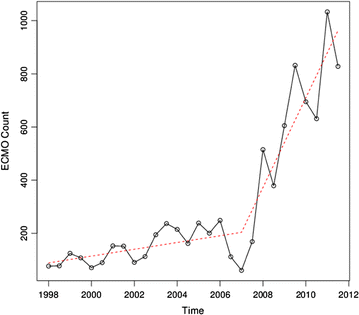Increased trend in extracorporeal membrane oxygenation use by adults in the United States since 2007
- PMID: 26581610
- PMCID: PMC4650500
- DOI: 10.1186/s13104-015-1678-7
Increased trend in extracorporeal membrane oxygenation use by adults in the United States since 2007
Abstract
Background: Extracorporeal membrane oxygenation (ECMO) has been increasingly studied as a life support modality, but it is unclear if its use has changed over time. Recent publication shows no significant trend in use of ECMO over time; however, this report does not include more recent data. We performed trend analysis to determine if and when the use of ECMO changed in the past decade.
Results: We identified hospitalizations (2000-2011) in the Nationwide Inpatient Sample during which ECMO was recorded. We used a segmented linear regression model to determine trend and to identify a temporal change point when rate of ECMO use increased. ECMO use gradually grew until 2007, at which time there was a dramatic increase in the rate (p = 0.0003). There was no difference in mortality after 2007 (p = 0.3374), but there was longer length of stay (p = 0.0001) and smaller percentage of women (p = 0.005).
Conclusions: There has been a marked increase in ECMO use since 2007. As ECMO use becomes more common, further study regarding indications, cost-effectiveness, and outcomes is warranted to guide optimal use.
Figures
References
-
- Khoshbin E, Roberts N, Harvey C, Machin D, Killer H, Peek GJ, Sosnowksi AW, Firmin RK. Poly-methyl pentene oxygenators have improved gas exchange capability and reduced transfusion requirements in adult extracorporeal membrane oxygenation. ASAIO J. 2005;51(3):281–287. doi: 10.1097/01.MAT.0000159741.33681.F1. - DOI - PubMed
-
- Peek GJ, Mugford M, Tiruvoipati R, Wilson A, Allen E, Thalanany MM, Hibbert CL, Truesdale A, Clemens F, Cooper N, Firmin RK, Elbourne D. CESAR trial collaboration: efficacy and economic assessment of conventional ventilatory support versus extracorporeal membrane oxygenation for severe adult respiratory failure (CESAR): a multicentre randomised controlled trial. Lancet. 2009;374(9698):1351–1363. doi: 10.1016/S0140-6736(09)61069-2. - DOI - PubMed
-
- Davies A, Jones D, Bailey M, Beca J, Bellomo R, Blackwell N, Forrest P, Gattas D, Granger E, Herkes R, Jackson A, McGuinness S, Nair P, Pellegrino V, Pettilä V, Plunkett B, Pye R, Torzillo P, Webb S, Wilson M, Ziegenfuss M. Extracorporeal membrane oxygenation for 2009 influenza A(H1N1) acute respiratory distress syndrome. JAMA. 2009;302(17):1888–1895. doi: 10.1001/jama.2009.1535. - DOI - PubMed
Publication types
MeSH terms
Grants and funding
LinkOut - more resources
Full Text Sources
Other Literature Sources
Research Materials
Miscellaneous


